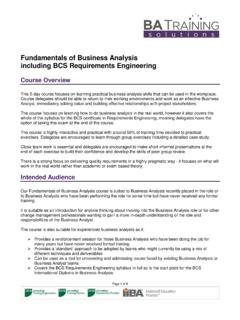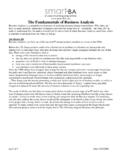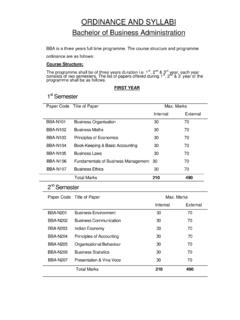Transcription of Best Practices Guide: Fundamentals of a Workplace …
1 Practices Guide: Fundamentals of aWorkplace First-AidProgramOSHA 3317-06N 2006 This best Practices guide is not a standard orregulation, and it creates no new legal obligations,nor does it change any existing OSHA standard orregulation. The guide is advisory in nature, infor-mational in content, and is intended to assistemployers in providing a safe and Occupational Safety and Health Act of 1970(OSH Act) requires employers to comply withhazard-specific safety and health standards andregulations as issued and enforced by either the Federal Occupational Safety and HealthAdministration (OSHA), or an OSHA-approvedState Plan. In addition, employers must providetheir employees with a Workplace free fromrecognized hazards likely to cause death or seriousphysical harm under Section 5(a)(1), the GeneralDuty Clause of the Act.
2 Employers can be cited forviolating the General Duty Clause if there is arecognized hazard and they do not take steps toprevent or abate the hazard. However, failure toimplement this guide is not, in itself, a violation ofthe General Duty Clause. Citations can only bebased on standards, regulations, and the GeneralDuty Clause. Department of LaborOccupational Safety and Health AdministrationOSHA 3317-06N2006 Best Practices Guide: Fundamentals of aWorkplace First-AidProgram2 ContentsIntroduction and Purpose .. 3 The Risks: Injuries, Illnesses and Fatalities .. 4 Assess the Risks and Design a First-Aid Program Specific for the Worksite .. 5 OSHA Requirements .. 8 First-Aid Supplies .. 9 Automated External Defibrillators .. 10 First-Aid Courses .. 11 Elements of a First-Aid Training Program .. 11 Trainee Assessment.
3 15 Skills Update .. 15 Program Update .. 15 Summary .. 16 Additional Resources on First Aid, CPR and AEDs .. 16 References .. 17 OSHA Assistance .. 18 OSHA Regional Offices .. 23 Introduction and PurposeFirst aid is emergency care provided for injury or sudden illnessbefore emergency medical treatment is available. The first-aidprovider in the Workplace is someone who is trained in the deliveryof initial medical emergency procedures, using a limited amount ofequipment to perform a primary assessment and interventionwhile awaiting arrival of emergency medical service (EMS) Workplace first-aid program is part of a comprehensive safetyand health management system that includes the following fouressential elements1: Management Leadership and Employee Involvement Worksite Analysis Hazard Prevention and Control Safety and Health TrainingThe purpose of this guide is to present a summary of the basicelements for a first-aid program at the Workplace .
4 Those elementsinclude: Identifying and assessing the Workplace risks that have potentialto cause worker injury or illness. Designing and implementing a Workplace first-aid program that: Aims to minimize the outcome of accidents or exposures Complies with OSHA requirements relating to first aid Includes sufficient quantities of appropriate and readilyaccessible first-aid supplies and first-aid equipment, such asbandages and automated external defibrillators. Assigns and trains first-aid providers who: receive first-aid training suitable to the specific Workplace receive periodic refresher courses on first-aid skills 03-01-002 - TED - Voluntary Protection Programs (VPP): Policies andProcedures Manual Notice. 54 Federal Register 3904-3916. Available Instructing all workers about the first-aid program, includingwhat workers should do if a coworker is injured or ill.
5 Puttingthe policies and program in writing is recommended toimplement this and other program elements. Providing for scheduled evaluation and changing of the first-aidprogram to keep the program current and applicable to emergingrisks in the Workplace , including regular assessment of theadequacy of the first-aid training guide also includes an outline of the essential elements ofsafe and effective first-aid training for the Workplace as guidance toinstitutions teaching first-aid courses and to the consumers ofthese courses. The Risks: Injuries, Illnesses and Fatalities There were 5,703 work-related fatalities in private industry in that same year there were million total Workplace injuriesand illnesses, of which million resulted in days away illnesses, injuries and fatalities in 2004 cost theUnited States economy $ billion, according to NationalSafety Council average cost per occupationalfatality in 2004 exceeded one million dollars.
6 To cover the costs toemployers from Workplace injuries, it has been calculated thateach and every employee in this country would have had togenerate $1,010 in revenue in cardiac arrest (SCA) may occur at work. According torecent statistics from the American Heart Association, there are250,000 out-of-hospital SCAs annually. The actual number of SCAsthat happen at work are unknown. If an employee collapseswithout warning and is not attended to promptly and effectively,the employee may die. Sudden cardiac arrest is caused byabnormal, uncoordinated beating of the heart or loss of theheartbeat altogether, usually as a result of a heart Safety Council. (2006).Injury Facts,2004 - 2006 Edition. Itasca, IL, p. events such as electrocution or exposure to low oxygenenvironments can lead to SCA. Overexertion at work can alsotrigger SCA in those with underlying heart disease.
7 The outcome of occupational illnesses and injuries depends onthe severity of the injury, available first-aid care and medicaltreatment. Prompt, properly administered first aid may mean thedifference between rapid or prolonged recovery, temporary orpermanent disability, and even life or the Risks and Design a First-AidProgram Specific for the Worksite Obtaining and evaluating information about the injuries, illnessesand fatalities at a worksite are essential first steps in planning afirst-aid program. Employers can use the OSHA 300 log, OSHA301 forms, their Workers Compensation insurance carrier reportsor other records to help identify the first-aid needs for theirbusinesses. For risk assessment purposes, national data forinjuries, illnesses and fatalities may be obtained from the Bureauof Labor Statistics (BLS) website at The annualdata, beginning in 2003, are grouped by the North AmericanIndustrial Classification System (NAICS) that assigns a numericcode for each type of work establishment.
8 Prior to 2003, theStandard Industrial Classification (SIC) system was used tocategorize the data instead of NAICS. The graphs that follow provide examples of fatality, injury andillness analyses that can be developed using BLS 1 shows the distribution by NAICS sector of workplacefatalities that occurred in private industry in 2004, the mostrecent year for which data was categories of events or exposures responsible for workplacefatalities in 2004 are shown in Figure 2. More detailed data areavailable from the BLS 5 10 15 20 25 30 InformationFinancial ActivitiesEducation and health servicesOther servicesLeisure and hospitalityProfessional and business servicesManufacturingNatural resources and miningConstructionTrade, transportation and utilitiesPercent Fatalities of 5,703 total fatalitiesNote: The total includes fatalities that occurred in the public sector;therefore, the percentages above do not add up to 1.
9 Percent Fatalities in Private Industry by NAICS Sector, 2004 NAICS Sector0 5 10 15 20 25 30 35 40 45 50 Fires and explosionsExposure toharmful substancesFallsAssaults and violent actsContact with objects and equipmentTransportation incidentsPercent of 5,703 total fatalitiesFigure 2. Occupational Fatalities by Event or Exposure, 2004 Event or ExposureFigure 3 reflects total injuries and illnesses by NAICS sector basedon 2004 BLS data. Data that are more specific to businesses withinthese sectors may be obtained from the BLS graph in Figure 4 shows the number of injuries and illnessesin private industry by the type of event or exposure responsible forthem that resulted in days away from work in 2004. More detaileddata may be found on the BLS 200,000 400,000 600,000 800,000 1,000,000 1,200,000 1,400,000 InformationNatural resourcesand miningOther servicesFinancial activitiesProfessional and business surfacesLeisure andhospitality ConstructionEducational andhealth servicesManufacturingTrade, transportationand utilitiesNumber of Recordable Injuries and IllnessesFigure 3.
10 Number of Recordable Injuries and Illnesses by NAICS Sector, 2004 NAICS Sector0 10 20 30 40 50 60 70 Fires and explosionsAssualts andviolent actsExposure to harmful substances or environmentsTransportationaccidents FallsContact with objectsand equipmentBodily reactionand exertionInjuries and Illnesses with Days Away from Work per 10,000 EmployeesFigure 4. Private Industry Injuries and Illnesses Involving Days Away from Work per 10,000 Employees by Event or Exposure, 2004 Event or ExposureEmployers should make an effort to obtain estimates of EMSresponse times for all permanent and temporary locations and forall times of the day and night at which they have workers on duty,and they should use that information when planning their first-aidprogram.
















